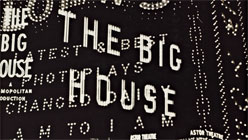Walker Evans, now through April 8, 2012, at the Cantor Arts Center on the Stanford campus, gets into the good stuff quickly. Dutifully, the 125-plus-piece exhibition opens with three modest self-portraits taken in Paris (1926) and a small collection of formal, modernist studies of New York skyscrapers (late 1920s). This is an artist finding himself, doing the things he’s been told are important. But once he got beyond these predictable exercises in narcissism and conventional wisdom, Evans found his footing, roaming the streets of New York City to see what his camera could find.

Walker Evans, Broadway, 1930; Lent by Elizabeth and Robert J. Fisher, c. Walker Evans Archive, The Metropolitan Museum of Art.
One of its first discoveries became New York Lunch Counter, 1930. Shot from the sidewalk into a café whose window advertises “ICE COLD MILK,” the photograph captures a man in a straw boater drinking, naturally, a glass of milk. He’s staring back at Evans as he gulps, with a ‘What could possibly be so interesting to that fellow?’ expression on his face. Well, that sourpuss expression for one, along with the fact that he’s not centered in the frame despite being the picture’s primary subject. In fact, our eye is so busy darting between him and the customer to his left, who’s tucking into a messy lunch, it takes us a moment before we connect the drink the man’s downing with the loud advertisement on the café’s plate glass.
On their surfaces, photos like New York Lunch Counter suggest that Evans understood well the role he could play as a documentarian, but he also seemed aware that his presence as an observer could affect the things he was trying to document. The observer’s effect, in this case, was the man in the boater’s expression.

Walker Evans, Alabama Tenant Farmer, 1936; Lent by Elizabeth and Robert J. Fisher, c. Walker Evans Archive, The Metropolitan Museum of Art.
Similarly, Evans was not just a fly on the wall when he photographed sharecroppers in West Virginia for the Resettlement Administration, which became the Farm Security Administration, during the depths of the Depression. Along with Dorothea Lange, Arthur Rothstein and others, Evans brought the realities of rural poverty to a weary nation. In photos such as West Virginia Living Room, 1935, Evans documents a barefoot boy sitting in a wooden chair, who faces Evans right back. Ostensibly, the photo’s a portrait, but the youth may not have realized he’d be competing for our attention with the irony of his surroundings. To his left, a wooden wall has been insulated by cardboard advertisements of healthy, smiling people, whose packaged prosperity seems a mockery of the lad’s harsh circumstances. There’s even a Santa Claus on the wall, not because it’s a friendly image brightening the grimness that typified life in the mining town of Scotts Run, but because it kept the cold out.



